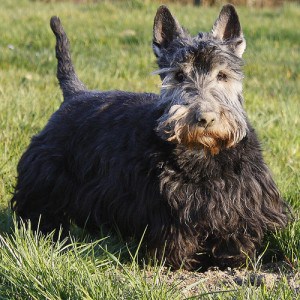From the Desk of Sharda Baker
Good day and welcome everyone!
Hello everyone!
This is Sharda again for another Scottish Terrier newsletter.
Let’s have a look at the Scottish Terrier History and its early beginnings.
Like all terrier breeds the exact origin of the Scottish Terrier is uncertain, but it likely that the breed is one of the terrier crosses that occurred from basic terrier stock.
Prior to the 1800’s, the terriers bred in Scotland were simply grouped into two categories; long-legged and short-legged.
The early Scottish Terrier was, of course, in the short-legged group.
Terriers were all similar, in that they had a rough wiry coat and were used to hunt vermin, fox and other game.
The short-legged terriers were used to burrow and chase after smaller animals, and keep the farms and houses rat free.
The Scottish Terrier had to be independent, able to survive in the rugged terrain and harsh conditions of the Scottish highlands, and still be a loyal dog and good protector for the family home.
Original grouped with the Cairn, West Highland White, and Dandie Dinmont, the Scottish Terrier was simply a terrier in the group until dog fanciers began to distinguish between the different characteristics of the breeds.
The Dandie Dinmont Terrier, due to its distinctive appearance first broke away from the group, while the other three terrier breeds continued to be shown as Scottish Terriers.
The first Scottish Terrier that had the same defining characteristics as the modern Scottie was shown in Great Britain in 1860. The all black, wheaten or brindle terrier was also known as the Aberdeen Terrier, named after a town in Scotland where the breed was popular.
In 1881 the Scottish terrier owners decided to set breed standards and distinguish the Scottie from the other breeds being shown under the category of “Scottish terriers”.
Originally called the “Hard-haired Scotch Terrier” the name was soon shortened to the Scottish Terrier. A club was formed and standards established in 1887 in England, and in 1888 in Scotland that were recognized by the Kennel Club.
The first Scottish Terrier came to the United States in the early 1800’s and the first Scottie registered with the American Kennel Club was in 1885. Shortly after that in 1900 the Scottish Terrier Club of America was formed.
MORE RECENT HISTORY
Scottish Terriers continue to be among the most popular breeds of terriers. They have maintained both their independent personalities and their protective nature.
Many famous people have owned Scottish Terriers, both historically and currently.
Some of the more famous owners of Scotties are:
- Queen Victoria
- President Franklin Roosevelt
- President Eisenhower
- President George W. Bush
- President Ronald Reagan
- Charles Lindbergh
- Jackie Kennedy
- Monsieur Balladur
- Humphrey Bogart
- Bette Davis
- Shirley Temple
- E.B White
This is just a small sampling of the number of famous people that have owned Scotties.
Perhaps one of the most well-known Scotties belonged to the crew of the Memphis Belle.
This WWII flight crew had a Scottie called Stuka that was their mascot.
Many Presidents and other heads of state have owned Scotties. Often the dogs were given as gifts, and ended up being members of the family in very short time.
Scottie owners claim that once you own one Scottie, you are destined to own more, as their engaging personalities and temperaments will quickly turn you into a strong supporter of the breed.
SCOTLAND
The Scottie has come to symbolize Scotland, and most products and exports from the country bear a silhouette of a Scottie either in black or plaid, on the item or on the packaging.
The dog has come to represent the personality of the Scottish people and their independence and hardiness.
Modern Scotties are known for their fierce loyalty and protective instincts towards their families. Their coats are necessary in the harsh Scottish weather, and are almost free from shedding, so often people with allergies to dog hair are able to tolerate a Scottie.
In addition, they are excellent dogs in most climates, and enjoy being outside and spending time with their owners.
I hope you learned a lot from today’s Scottish Terrier Newsletter.
All the best and take care
Warmly,
Sharda Baker

